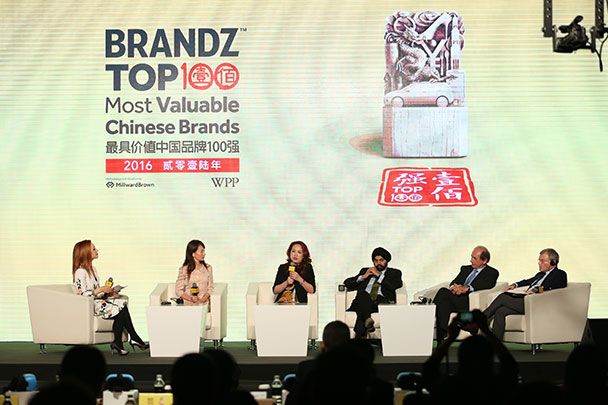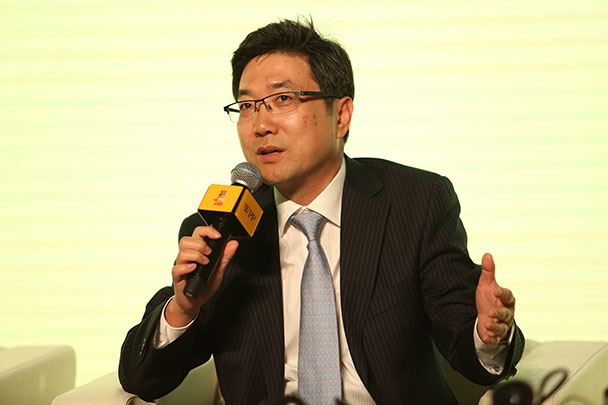As the Chinese economy slows, consumers’ spending priorities change and markets saturate, it becomes more important than ever for companies to rethink their strategies and innovate. It is against this backdrop that WPP organized the BrandZ Top 100 Most Valuable Chinese Brands forums in Beijing and Shanghai, on March 21 and 24 respectively, in partnership with the Cheung Kong Graduate School of Business (CKGSB).
The BrandZ Top 100 Most Valuable Chinese Brands forums convened some of the world’s most successful business leaders, including WPP CEO Sir Martin Sorrell, Nestlé CEO Paul Bulcke, Mastercard CEO Ajay Banga and Mengniu CEO Sun Yiping, who is also a CKGSB student, to shed light on the latest marketing trends and best practices. Joining these CEOs were CKGSB Associate Dean and Associate Professor of Strategic Management Teng Bingsheng and Assistant Dean Zhou Li, who addressed how Chinese companies are innovating and differentiating their brands as they go global.

Left to right: CCTV News Host Martina Fuchs; Jane Sun, Co-President, Ctrip; Sun Yiping, CEO, Mengniu; Ajay Banga, CEO, Mastercard; Paul Bulcke, CEO, Nestlé; Sir Martin Sorrell, CEO, WPP
Building Strong Innovative Brands
Sir Martin Sorrell, CEO of the WPP Group, which employs 190,000 people and reported $19 billion in revenues last year, set the stage by painting a realistic picture of where the Chinese economy is today and how companies should adapt. “The 13th five-year plan will serve as a business strategy for WPP, in which we see a shift from savings to consumption, from manufacturing to services sectors,” he explained. “We don’t see a 6.5% growth rate for China, instead we see volatility.” Despite this, Sir Martin highlighted where opportunities lie, namely with strong brands. He revealed that the total value of the BrandZ Top 100 Most Valuable Global Brands increased 14 percent to $3.3 trillion in 2015, its highest level ever, despite the turbulent global economy.
Mengniu’s CEO Sun Yiping—who is currently undertaking CKGSB’s CKGSB Business Scholar Program (DBA)—was even more hopeful. “China’s deceleration of economic growth may be a good thing for Chinese companies,” she explained, “since it will force businesses to look within their companies and innovate, rather than simply grasp opportunities in the market.”
But how should brands innovate? Mastercard CEO Ajay Banga emphasized the importance of talent and the company culture that can foster innovation. “The pace of change in technology is so quick now,” Banga said, “so the sense of emergency is very important. You have to be able to question everything at all times with a sense of paranoia. Finally, you have to surround yourself with people who are different from you, otherwise you will keep hitting the same blind spots and repeating your mistakes.” Banga also stressed that creating the right culture for innovation must go side-by-side with brand building, as a brand is created by people.
CKGSB Assistant Dean Zhou Li emphasized that “at the Cheung Kong Graduate School of Business, we believe that innovation goes hand-in-hand with globalization and social responsibility or a humanistic spirit.” In fact, CKGSB has embodied this principle in its vision, programs and activities.
Dean Zhou then raised the important question of how are Chinese brands innovating differently compared to their global counterparts. Jules Young, Global Account Director of Kantar China, presented the successful example of Huawei. “Huawei has understood their global consumers’ concerns and innovated by improving their mobile phones’ battery life to last up to two days, which was a key need of their consumers that was previously unmet,” she explained. “Chinese brands are doing a fantastic job in grasping consumers’ needs and meeting them quickly,” Young said, “while global brands spend a greater amount of time researching, as compared to the fast test-and-learn approach of Chinese brands.”
The Rise of Chinese Brands on the World Stage
In China’s relatively volatile market last year, it was the stronger brands that endured and grew further. So what are the most valuable Chinese brands today? Moreover, as Chinese brands’ appetite for global expansion grows, how are they differentiating themselves on the world stage? WPP and CKGSB experts revealed some surprising results and practical tips on these issues.
According to WPP’s BrandZ—the world’s largest brand equity analysis—despite a slower economy and an erratic stock market in 2015, Chinese brands have risen in brand value by 13% and shifted to market-driven brands from state-owned brands. In fact, for the first time, market-driven brands made up more than half of the total value of the BrandZ China Top 100, 51%, and five of the Top 10 brands were market-driven, as compared to two years ago when there were only two such brands. Moreover, the technology category, especially mobile Internet brands, rose in prominence, as the country’s economic drive shifts from production to consumption. This is evident in the fact that four of the top five brands are such brands—Tencent (#1), China Mobile (#2), Alibaba (#3), and Baidu (#5). This also stems from the extensive use of mobile technology in China today, which comprises a 56% share of daily screen time (as opposed to 22% for desktop and 23% for TV).
Signaling great potential, brands ranked 11-to-100 grew over 30% in value, while the Top 10 grew only 3%. Meanwhile, the Top 10 brands create nearly two-thirds of the total value.
What does this mean for Chinese brands? China continues to offer great opportunities for brand growth, but the playing field is more complex and competitive. Since growth is slower and opportunities are harder to reach, companies must differentiate themselves more distinctively in China, but more importantly abroad. In fact, 14 Chinese brands are included in the Top 100 Most Valuable Global Brands, as opposed to just one brand ten years ago.
In differentiating their brands globally, should Chinese companies emphasize that they are “Made-in-China”? CKGSB Professor Teng Bingsheng advised companies not to. Prof. Teng explained that “While we can see that Chinese companies’ brand value is growing, they remain weak globally. Japanese brands that are doing well worldwide have taken more than 20 years to get to where they are today. Therefore, Chinese brands need at least another 10 years to develop themselves.” Prof. Teng raised a concrete example to illustrate his point, saying, “Tata would never emphasize that Jaguar Land Rover is an Indian brand. They instead stress the product’s value or differentiations.”
When developing brands globally, Chinese companies should rely on their products for differentiation. “This is the case for Alibaba and JD.com,” explained Prof. Teng. “Companies should look at what competitive advantages they have in China, as the same would apply abroad.”

CKGSB Associate Dean and Associate Professor of Strategic Management Teng Bingsheng
Key Lessons in Successful Brand Building
As the week-long activities brought by WPP, in partnership with CKGSB, came to an end in Beijing and Shanghai, participating companies left with practical takeaways that can help them further develop their brands in China and globally. For Chinese brands, differentiating themselves is going to be the long-term driver. Only innovative brands can sustain and increase their growth, for which investing in talent is crucial. Finally, mobility is a lifestyle in China and it will offer great success to brands that know how to leverage it.
However, this week was only a taster of the important trends and best practices that CEOs, Chief Marketing Officers and senior directors must know to advance their brands. To offer more comprehensive insights on such topics, CKGSB and WPP are offering a joint program in New York on Global Branding in the Digital Era from October 17-21, 2016.
This 5-day program is an opportunity for American and Chinese CMOs and other marketing executives to increase their effectiveness as digital marketing leaders on a global scale. Whether the area of interest is finance, healthcare or the sharing economy, participants will learn from CKGSB’s world-class faculty and WPP’s industry leaders on how to build long-lasting brands.
To learn more about Global Branding in the Digital Era program, please click here.